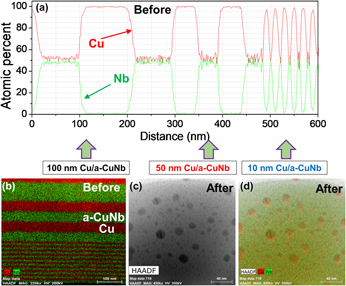Crossref Citations
This article has been cited by the following publications. This list is generated based on data provided by
Crossref.
Fan, Cuncai
Shang, Zhongxia
Niu, Tongjun
Li, Jin
Wang, Haiyan
and
Zhang, Xinghang
2019.
Dual Beam In Situ Radiation Studies of Nanocrystalline Cu.
Materials,
Vol. 12,
Issue. 17,
p.
2721.
Fan, Zhe
Yang, Tai-ni
Kombaiah, Boopathy
Wang, Xing
Edmondson, Philip D.
Osetsky, Yuri N.
Jin, Ke
Lu, Chenyang
Bei, Hongbin
Wang, Lumin
More, Karren L.
Weber, William J.
and
Zhang, Yanwen
2020.
From suppressed void growth to significant void swelling in NiCoFeCr complex concentrated solid-solution alloy.
Materialia,
Vol. 9,
Issue. ,
p.
100603.
Shang, Zhongxia
Ding, Jie
Fan, Cuncai
Chen, Di
Li, Jin
Zhang, Yifan
Wang, Yongqiang
Wang, Haiyan
and
Zhang, Xinghang
2020.
He ion irradiation response of a gradient T91 steel.
Acta Materialia,
Vol. 196,
Issue. ,
p.
175.
Tran, Anh-Son
2021.
Strengthening mechanism and plasticity deformation of crystalline/amorphous Cu/CuTa nanomultilayer.
Journal of Non-Crystalline Solids,
Vol. 559,
Issue. ,
p.
120685.
Jing, Hai-yan
Li, Ming-fei
Wang, Peng-wei
Malomo, Babafemi
and
Yang, Liang
2021.
Self-healing mechanisms of ZrCu nanocrystalline/amorphous laminated alloy under irradiation.
Materialia,
Vol. 20,
Issue. ,
p.
101227.
Fan, Zhe
Zhong, Weicheng
Jin, Ke
Bei, Hongbin
Osetsky, Yuri N.
and
Zhang, Yanwen
2021.
Diffusion-mediated chemical concentration variation and void evolution in ion-irradiated NiCoFeCr high-entropy alloy.
Journal of Materials Research,
Vol. 36,
Issue. 1,
p.
298.
Fan, Zhe
Zhong, Weicheng
Jin, Ke
Bei, Hongbin
Osetsky, Yuri N.
and
Zhang, Yanwen
2021.
Diffusion-mediated chemical concentration variation and void evolution in ion-irradiated NiCoFeCr high-entropy alloy.
Journal of Materials Research,
Vol. 36,
Issue. 1,
p.
298.
2021.
Amorphous Nanomaterials.
p.
189.
Devendhar Singh, Sanjay Kumar
Bawane, Kaustubh
Hu, Zhihan
Yang, Liuqing
Chen, Youxing
Shao, Lin
and
Lu, Kathy
2022.
Helium ion irradiation effects on microstructure evolution and mechanical properties of silicon oxycarbide.
Ceramics International,
Vol. 48,
Issue. 11,
p.
16063.
Wang, Peng-wei
Jing, Hai-yan
Li, Ming-fei
Malomo, Babafemi
and
Yang, Liang
2022.
Effective self-healing behavior of nanocrystalline-amorphous laminated alloy under irradiation.
Journal of Applied Physics,
Vol. 132,
Issue. 22,
Heidarnia, A.
and
Ghomi, H.
2023.
2MeV He ion irradiation of zirconium carbide coatings: Effects of substrate type.
Nuclear Instruments and Methods in Physics Research Section B: Beam Interactions with Materials and Atoms,
Vol. 541,
Issue. ,
p.
26.
Doan, Dinh-Quan
Fang, Te-Hua
and
Tran, Thi-Bao-Tien
2023.
Deformation behavior and strengthening mechanism of CuTa/CuTa amorphous/amorphous nanomultilayers.
Journal of Non-Crystalline Solids,
Vol. 600,
Issue. ,
p.
121993.
Çanakçı, Aykut
Karabacak, Abdullah Hasan
Çelebi, Müslim
Özkaya, Serdar
and
Arpacı, Kürşat Alp
2024.
A Study on the Optimization of Nano-B4C Content for the Best Wear and Corrosion Properties of the Al-Based Hybrid Nanocomposites.
Arabian Journal for Science and Engineering,
Vol. 49,
Issue. 11,
p.
14625.
Yan, Zhe
Yang, Wenfan
Pang, Jingyu
Yao, Jiahao
Zhang, Jian
Yang, Lixin
Zheng, Shijian
Wang, Jian
and
Ma, Xiuliang
2024.
Size effect of amorphous layers on radiation resistance in Cu/Nb multilayers.
Journal of Materials Science & Technology,
Vol. 197,
Issue. ,
p.
25.
Zolnikov, K. P.
Kryzhevich, D. S.
Korchuganov, A. V.
and
Berezikov, O. A.
2024.
Deformation behavior of Fe-10Ni-20Cr alloy at different irradiation doses.
Russian Physics Journal,
Vol. 67,
Issue. 12,
p.
2191.
Yadav, Digvijay
Derby, Benjamin K.
Powers, Max
Baldwin, Jon Kevin
Wang, Yongqiang
Misra, Amit
Xie, Kelvin Y.
and
Demkowicz, Michael J.
2025.
Influence of implantation temperature and He implantation-induced defects on morphological evolution of co-deposited Cu-Mo nanocomposites.
Journal of Nuclear Materials,
Vol. 607,
Issue. ,
p.
155645.
